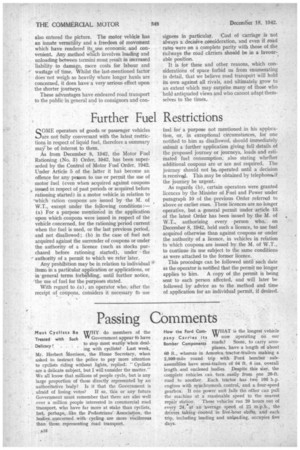Passing Comments
Page 18

Page 19

If you've noticed an error in this article please click here to report it so we can fix it.
WHY do members of the VI' Government appear to have to step most warily when dealing with cyclists? Last week, Mr. Herbert Morrison, the Home Secretary, when asked to instruct the police to pay more attention to cyclists riding without lights, replied: "Cyclists are a delicate subject, but I will consider the matter." We all know that millions of people cycle, but is any large proportion of these directly represented by an authoritative body? Is it that the Government is , afraid of losing votes? If so, this or any future Government must remember that there are also well over a million people interested in commercial road transport, who have far more at stake than cyclists, but, perhaps, like the Pedestrians' Association, the bodies. concerned with cycling are more vociferous than those representing road transport.
• 1,16 Must Cyclists Be Treated with Such Delicacy ?. . . . How the Ford CornWHAT iS the longest vehicle pany Carries its VI' now operating on our Bomber Components roads? Some, to carry aero planes, have a length of about 60 ft., whereas in America tractor-trailers making a 2,500-mile round trip with Ford bomber subassemblies have semi-trailers of 64 ft. 6 ins, overall length and enclosed bodies. Despite this size, the complete vehicles can turn easily from one 20-ft. road . to another. Each tractor has two 100 h.p. engines with synchromesh control, and a four-speed gearbox. If one power unit sails the other can pull the machine at a reasonable speed to the nearest repair station. These vehicles run 20 hours out of every 24, at an 'average speed of 25 m.p.h., the drivers taking Control in five-hour shifts, and each trip, including loading and unlpading, occupies five days.
NOT everyone is acquainted with the restrictions on the use of cars, hire cars and taxis, but these were brought into ,one document in the Control of Motor Fuel Order, which came into force on December 8 and which includes some new provisions. With private cars, the onus of proving that other mans for transport were not reasonably practicable for the particular journey rests with the "defendant." Taxis are normally restricted to within five miles from the nearest point on the boundary of the area in which they, ply for hire, except in prescribed cases of urgency, one of which is to enable members of H.M. and Allied Forces. and of the Merchant Navy to return from leave of not less than 48 hours. Hire Cars must not operate beyond a radius of 10 miles from their garages, or 75 miles for special purposes subject to a declaration Further Limitations on the Use of .Cars and
Cabs by the hirer ; beyond this, hiring is limited to a small number of prescribed purposes wfiere other means for travel are impracticable.
Is This a Loophole in the Tyre Census Scheme ) AN interesting query has been. raised with us regarding the compulsory census of vehicles and tyres. A" laid-up vehicle" is one which is unlicensed or for which no petrol ration was granted for any period after October 28. Now, trade plates in the hands of motor-agent' custodians" embrace all the vehicles in their possession, and a ration of petrol is allocated to the plates to cover the vehicles upon which they are used. It would appear that this is a technical omission in the census recpiirements, but we would advise traders not to take advantage of it, for the hole, if any, would quickly be plugged.




















































